Keyes Farm Conservation Area self guided natural history walk
Pat Rice: plant ecologist looking for an excuse to be outside
Parking: From Pepperell Town Hall, follow Elm St. south. Just past Shirley St. there is a gravel parking area on left. The trailhead is behind the kiosk.
Pepperell Trail Guide Reference: The Keyes-Farm Conservation Area map and description is available on the Nashoba Conservation Trusts website here Pepperell Trail Guide or on the Town Of Pepperell website here Pepperell Trail Guide
Self-Guided Trail: Stating at the information kiosk, follow the marked blue trail east, which will be flagged from April 21-May 8ish
Spring is here and plants flowering and leafing out, and showing who they are, and we want to get out and enjoy our trails and nature in town. I’m using the hope that other people would like to know what’s going on with the plants along our trails to get out on them myself. I’m going to pick a trail and tie orange flags to particular plants (or sometimes near them) with the names on them and sometimes some natural history observations. Because the flags are picking up on time sensitive points such as flowers or early leaves I’ll leave the flags out for about 2 weeks, then remove them from any given trail. The trails and plants will still be there after the flags are removed (well, some of the invasives may get clipped). Mostly I will be noting seasonal changes of our native plants. But, I’ll also note some of the invasive plants with comments on their effects on the native plant communities.
General observations:
At the Keyes Farm conservation area, the trail includes sections of a roughly constructed board walk through wet areas. The boards are solid, but relatively narrow and balance will help. I don’t think a baby stroller would work well. Please do not walk in the mud or wet areas, that creates a lot of disturbance.
Ticks: Just be careful to check yourself after a walk. Spraying insecticide on your clothes can deter them, but check anyway.
Black flies : Are out. Again, insecticide on clothing and hats discourages them, but they’re there and active.
Poison Ivy: The oils are present year around, don’t grab the branches, roots or stems. Wash with a good soap after exposure.
I put up flagging in the parking area and then to just past the end of the wetland area where the trail goes up a slight incline. The blue trail continues through the forest to a red marked loop that goes south and east before turning north and then rejoining the blue trail. Although I didn’t flag the red trail, it is a neat area that I will discuss below with some photos to highlight different observations. The Blue trail continues to the east and around a grassy field, but I am not including that portion in this description.
Flagging up on April 21, it’ll be there through about May1. I haven’t tagged everything interesting, look around as you go! The parking lot has some surprises. The area has been very disturbed in the past and MANY non-native invasive species are established, and appropriate native species as well.
1. Box elder is actually a native maple, a small tree. I usually see it along rivers.
2. Large white pines with side branches indicating it grew in the sun. These and those in the forest the trails go through are big old trees that likely started in an old pasture where their seeds were able to burrow through dense grasses to reach mineral soil and become established.
3. All around the edges are invasives including garlic mustard and wild garlic (break off a leaf and smell either or both of these), with multiflora rose and oriental bittersweet.
4. Follow the trail into the woods, there are still invasive plants, but also a higher proportion of natives. Most of the trees will be more identifiable when their leaves emerge. The area has stone walls, signs of past land clearing. Sometimes it is possible to note that there were different past land uses on the different sides of a wall where different trees dominate or they are different sizes (ages). There are often larger trees along the walls. Sometimes farmers left trees along the walls to provide shade for pasturing animals, or sometimes that’s where trees could get established when the fields were in use.
5. Plants on the forest floor are beginning to emerge or put out leaves. There are small and large patches of Canada mayflower leaves. The plants with more than one leaf will put up flowers soon. Star flowers were not blooming when I flagged the plants. Currents are small shrubs with maple-like opposite leaves - this one is our native swamp red current (flowering off trail in the woods near the parking lot).
6. Off trail there are invasive barberry plants, low shrubs greening up and getting ready to flower. We’ll see more of these along the stream near the red trail.
7. Evergreen plants like the partridgeberry are identifiable year around. Further along in the woods we’ll see wintergreen on the forest floor as well.
8. Hemlocks are low evergreen trees in these woods. The ones I checked here did not have the invasive wooly adelgid insects on their branches. Good news! Hemlocks have short, single needles with lighter stripes on the backs. The white pines have 5 long needles in each group, and look (and are) soft.
9. In the wetlands as we approach the boardwalks through the wettest parts are plants adapted to growing in wetter soils, and often somewhat sunnier places than under the evergreen canopy of white pine and hemlocks. There are horsetails sprouting up through multiflora rose plants. Sensitive ferns have new delicate leaves unfurling near last year’s fertile woody looking stalks.
10. Short paired leaves of impatiens (touch-me-not, jewelweed) are growing from seed in the mud next to the boardwalk. These will grow to dense 3-4 foot high plants with spotted orange flowers.
11. There is a marsh marigold flowering right next to the boardwalk. These grow in slowly moving water, or next to intermittent streams rather than still water of marshes. Round yellow flower clusters on spicebush are being joined by small leaves on the shrub’s branches.
12. Highbush blueberry tends to be in wetter areas, and lowbush blueberry is often a ground cover in dry forests, bedrock openings, and on sand. A medium sized blueberry is starting to flower at about the end of the wet area. I don’t know if this is a small highbush blueberry or one of the medium sized types. With full leaves and flowers or fruits they will be easier to tell apart.
13. Hornbeam (ironwood, blue beech, musclewood) is another small tree often found in moist conditions, near streams or edges of wetlands. They are in the birch family and have catkins releasing pollen into the air. I think this is the last plant I flagged along the trail but there are more plants of interest ahead, some of which I’ll discuss. Individuals of hornbeam, some quite large, continue into the forest.
14. A patch of mountain laurels grows on the side of the trail, not flowering yet (expected in June), but its evergreen leaves identify the plant.
I continued along the blue trail to the red loop trail to the right (south).
Look for flowering Canada mayflowers, bellworts, star flowers, and other low growing herbaceous plants under the forest canopy of large white pines, red maples, and small ash trees.
Along the way notice the abundant broken up white pine cones left by squirrels, maybe other animals looking for the seeds. These dense cone scales can mulch the ground keeping other plants from growing. Woodpeckers make h oles looking for insects to eat.
A partially rotted standing white pine shows the old branches inside the trunk. These would be knots if the tree had become timber.
Native tree saplings along the trail include hickories with beautiful large buds and beech with long pointed buds.
Rounding a curve on the red trail, a wetland along a stream becomes visible. This time of year the dense green undergrowth is barberry, with taller multiflora rose and even taller buckthorns.
Where the trail turns left (north) a bridge crosses the stream where that trails goes to the town forest. Take a minute and stand on the bridge. To the east are fewer invasives where the land is steeper next to the stream. Along the wet areas near the stream are false hellebore, marsh marigold, meadow rues, and at least 5 different kinds of ferns (not all of which I managed to identify to species).
If you are going back to the parking lot, turn left (north) on the trail and go left (west) on the first trail that crosses (the blue trail). Along the way notice the successional forest dominated by black (sweet) birch and white pine. There are black, red, and white oaks in the forest that will be expected to become dominant over the next decades as the successional species don’t replace themselves (they don’t usually grow well in the shade). Understory species include clubmosses, pipsissewa in bud, and the ground covers already discussed, mostly Canada mayflower, partridgeberry, wintergreen, and bellworts.
Open grown white pine with side branches that grew but later died in the increasingly shady conditions.
Canada mayflower about to flower
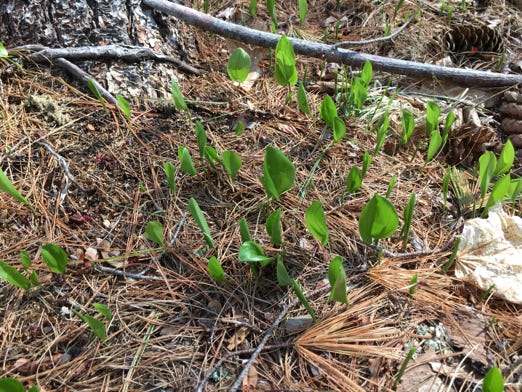
Canada mayflower patch
Patches of Canada mayflower are a regular component of the ground cover of pine forests (and many other types as well).

barberry showing prickers and flower buds
horsetails (the plants with whorled branches) grow in wetlands with a mix of other species. The red in the photo are maple flowers that have fallen from the surrounding trees.
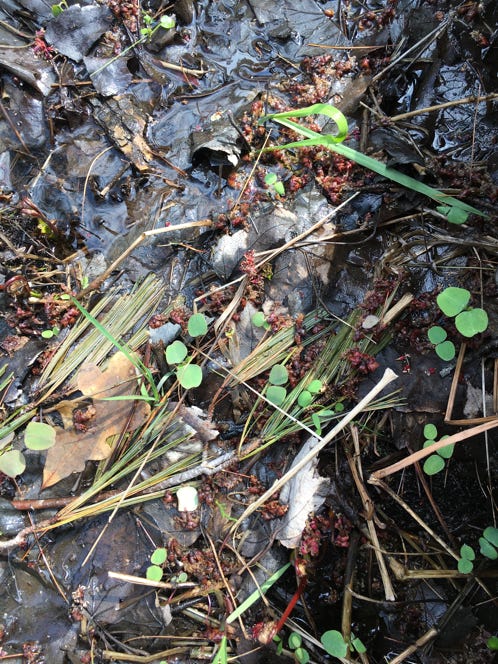
touch-me-not seedlings
Paired first leaves of Impatiens (touch-me-not) seedlings will grow in wet places, usually not standing water.
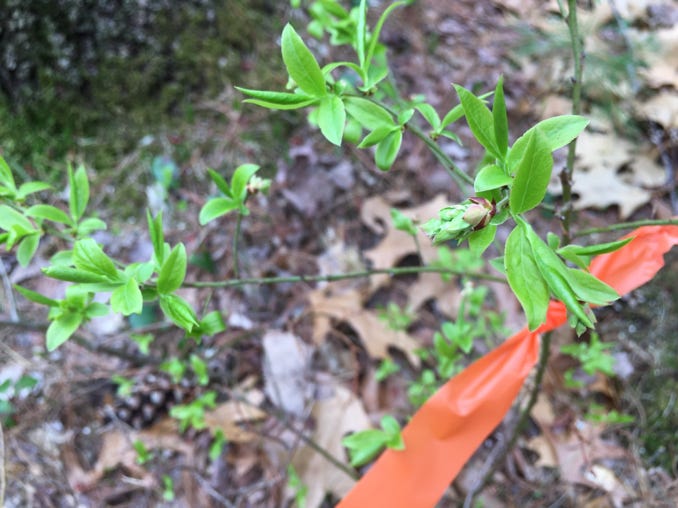
Image left: blueberry about to open flower.
Blueberries have white flowers that are somewhat bell shaped.
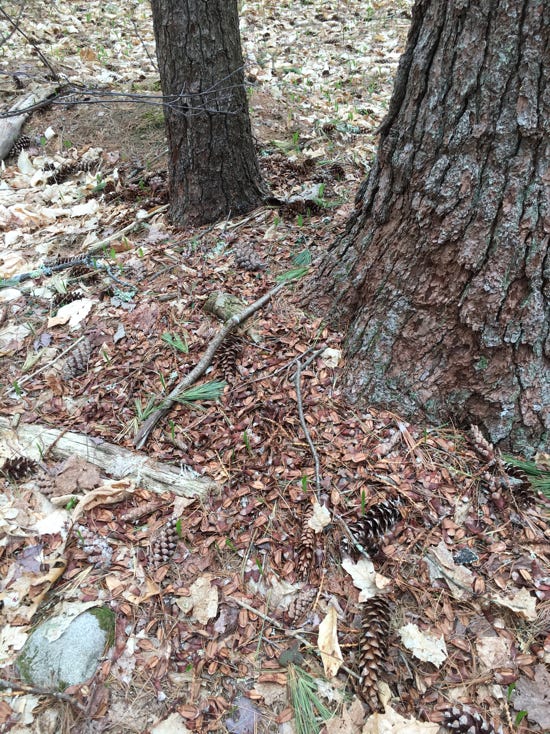
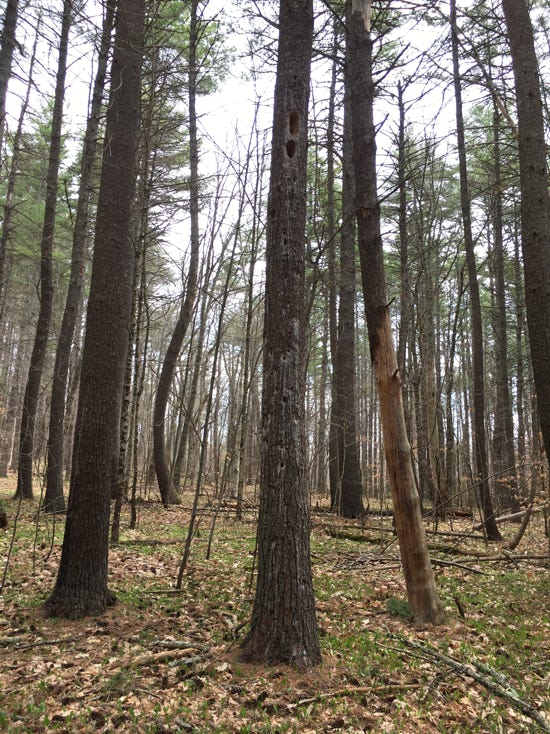

dismantled pine cones
woodpecker holes in trees
hickory bud
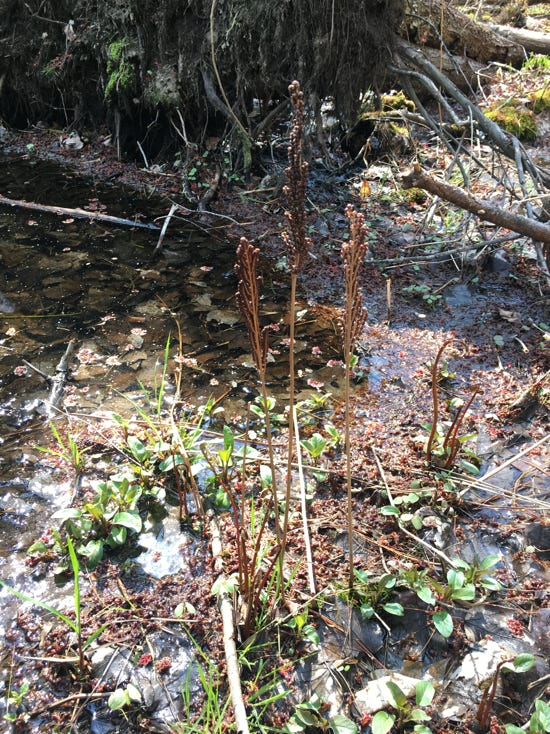
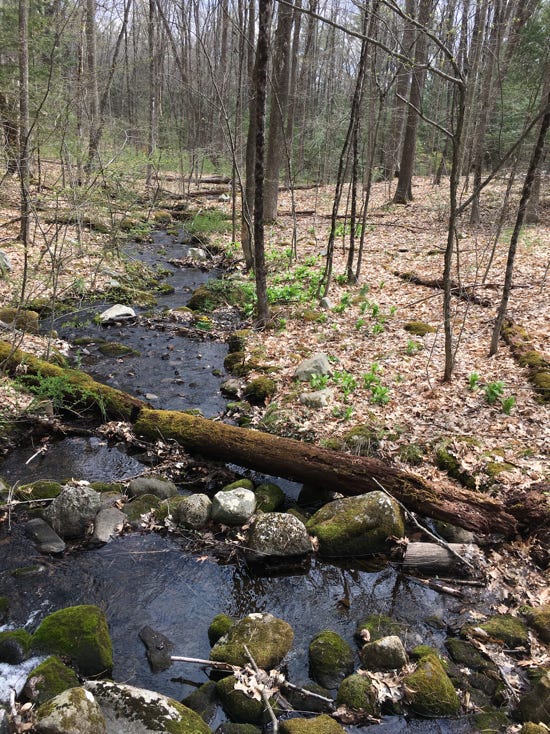
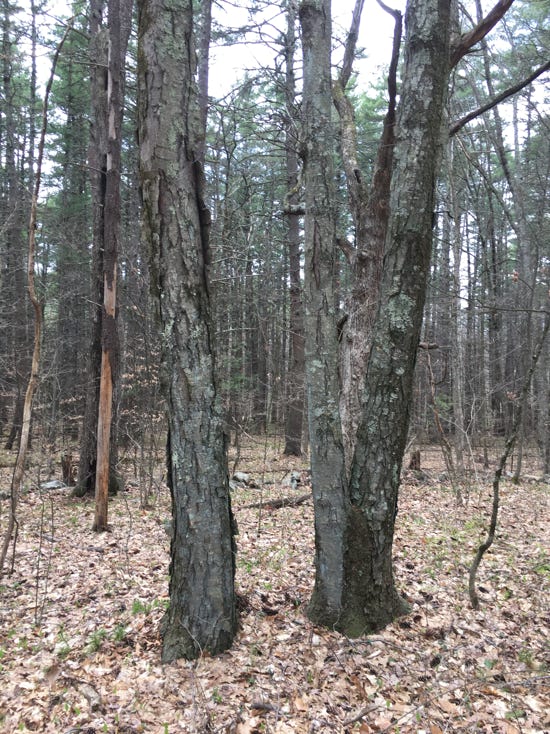
sensitive ferns
downstream from the bridge
black birch
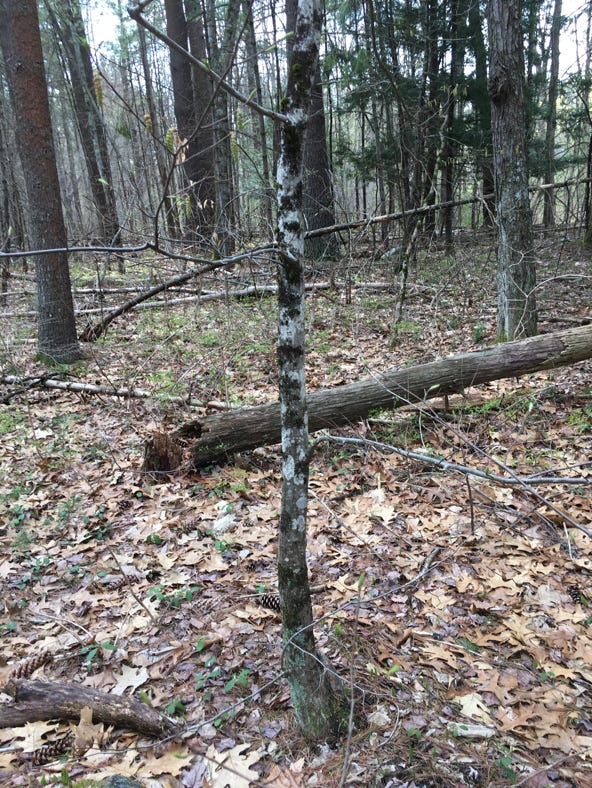
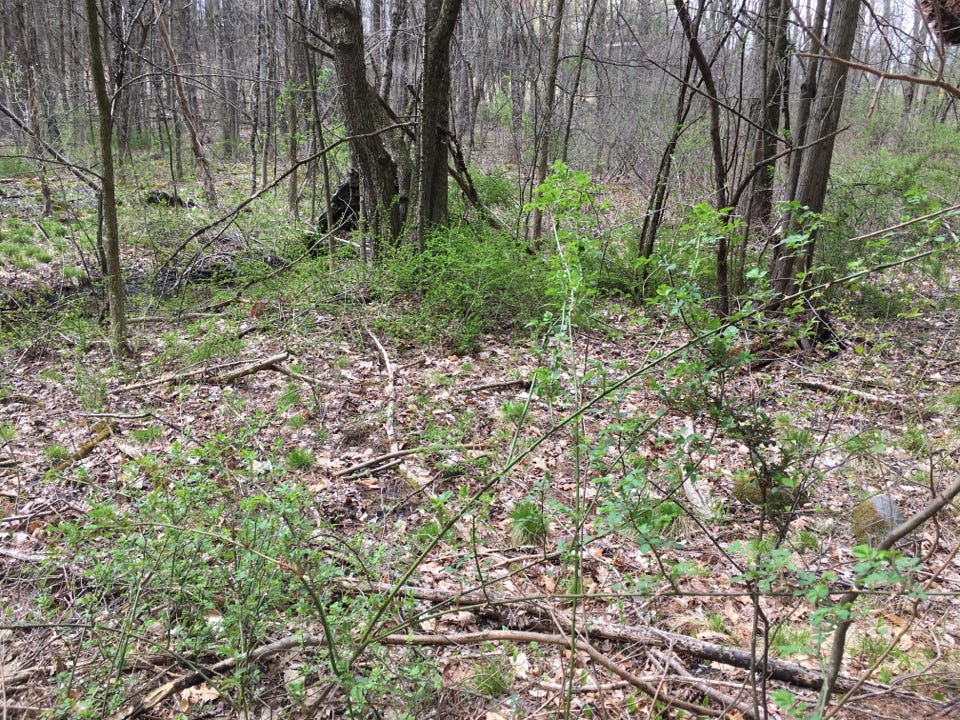
hornbeam
The wood below the smooth bark of hornbeam often looks like a flexing muscle, a nice character for identifying the small tree
invasives along the stream
The invasives have greened-up before most natives along the stream on the red trail. The layers here include short bayberry, taller multiflora rose, and buckthorns that are short trees.
All rights reserved. All content on this site property of Nashoba Conservation Trust.
Do not copy or reproduce in any form for any reason without written permission from Nashoba Conservation Trust.